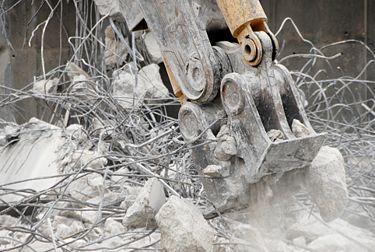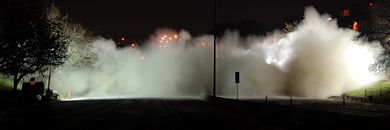Demolition and Removal of Improvements: Difference between revisions
m updated title |
m References to ten districts and "District 3", etc. were removed. |
||
| Line 25: | Line 25: | ||
:*The estimated dates for possession of each parcel and the deadline for needing the inspection report | :*The estimated dates for possession of each parcel and the deadline for needing the inspection report | ||
It is important for the inspectors to have either a contact person in the district that is familiar with the properties or photographs of the buildings taken from the road so a positive identification can be made of each structure requiring inspection. Construction and Materials personnel will take samples of all suspected ACM and painted concrete and will report test results to the district on [http://epg.modot.mo.gov/forms/CO/Asbestos%20Survey%20Report%20-%20All%20Suspect%20ACM%20%20(Form%20T746).dot Forms T746], [http://epg.modot.mo.gov/forms/CO/Asbestos%20Survey%20Report%20-%20Nonfriable%20ACM%20(Form%20T747).dot T747], and [http://epg.modot.mo.gov/forms/CO/Asbestos%20Survey%20Report%20-%20All%20Materials%20(Form%20T748).dot T748]. All contract proposals requiring asbestos abatement or demolition of buildings and bridges must include copies of these forms. Only the ACM listed on Form T748 will be tabulated for removal. The environmental specialist in the Design Diviison receives copies of all asbestos/painted concrete, block, and brick inspection forms for all | It is important for the inspectors to have either a contact person in the district that is familiar with the properties or photographs of the buildings taken from the road so a positive identification can be made of each structure requiring inspection. Construction and Materials personnel will take samples of all suspected ACM and painted concrete and will report test results to the district on [http://epg.modot.mo.gov/forms/CO/Asbestos%20Survey%20Report%20-%20All%20Suspect%20ACM%20%20(Form%20T746).dot Forms T746], [http://epg.modot.mo.gov/forms/CO/Asbestos%20Survey%20Report%20-%20Nonfriable%20ACM%20(Form%20T747).dot T747], and [http://epg.modot.mo.gov/forms/CO/Asbestos%20Survey%20Report%20-%20All%20Materials%20(Form%20T748).dot T748]. All contract proposals requiring asbestos abatement or demolition of buildings and bridges must include copies of these forms. Only the ACM listed on Form T748 will be tabulated for removal. The environmental specialist in the Design Diviison receives copies of all asbestos/painted concrete, block, and brick inspection forms for all the districts. These inspection forms are reviewed primarily to determine whether any painted concrete, block or brick surfaces exceed levels allowed for use as clean fill. The environmental specialist will notify the district personnel identified in the memo transmitting the results if there are areas identified in the structure that require disposal in a demolition or sanitary landfill. If a notification is not made, the painted concrete, block, and/or brick (if present) meets the definition of clean fill and can be managed as such, preferably on MoDOT right of way. | ||
===Asbestos Containing Materials=== | ===Asbestos Containing Materials=== | ||
Revision as of 13:10, 3 May 2012
| Return to EPG 127.8 Hazardous and Solid Waste |
| Return to EPG 236.5 Property Management |
When parcels containing buildings, structures, wells, septic tanks, individual lagoons, or other improvements that may remain vacant or unattended for an extended time are acquired, it is necessary to let a contract for demolition and removal of improvements in advance of the general roadway contract. This is done to remove safety hazards, minimize liability and maintain an orderly right of way. Specifications governing this work are contained in Section 202 of the Missouri Standard Specifications for Highway Construction. Demolition and removal activities are made most efficient by grouping together work from various projects within the district into a single contract.

The quantities in the proposal need to be tabulated by parcel for each roadway project on the program. It is recommended the district anticipate those parcels that will be acquired within a 12-month period throughout the district and include them in one contract for demolition and removal of improvements. Job Special Provision DSP-99-08D, Demolition and Removal Contract, must be included in demolition and removal contracts when MoDOT does not have possession of all parcels or an asbestos/painted concrete, block and brick inspection has not been completed on all structures prior to letting.
A notice to proceed must be issued in accordance with Standard Specifications. The notices to remove will apply only to structures to be demolished as part of the scope of work in the bidding documents for parcels that will be acquired by MoDOT after the letting. Standard specifications and job special provisions (JSPs) should designate petroleum storage tanks, lagoons, or other items that require early removal as a first or early order of work after notice to proceed. There may be special cases when abatement of asbestos containing materials (ACM), removal of tanks, and removal of buildings are included in the general roadway contract.
Requesting Asbestos/Painted Concrete, Block and Brick Inspection
It is necessary for all building structures, building remains, and bridges of which MoDOT takes possession to be inspected for the presence of asbestos containing materials (ACM) and heavy-metal-based painted concrete, block, and brick (referred to as “painted concrete”). Heavy-metal based painted concrete, block, and brick are surveyed to determine whether the material can be used as clean fill or if the material requires disposal in a demolition or sanitary landfill. Buildings, building remains/debris, and bridges should be inspected for ACM and painted concrete prior to salvage, demolition, and removal. The inspection methods are invasive and destructive; therefore, the department must have possession before inspection begins. If it is believed there will be salvage of a building by a third party, the request for asbestos/painted concrete, block and brick inspection should stipulate that non-destructive sampling methods be employed.
After MoDOT has taken possession, the district will submit a written request, containing the following information to the State Construction and Materials Engineer for asbestos/painted concrete, block and brick inspection.
- Job Number
- Parcel numbers to be inspected and the total number of parcels on the project requiring building demolition
- Addresses of the structures to be inspected
- Plan sheets showing the location of all parcels and structures
- A floor plan sketch of all buildings to be inspected, as may be used for appraisal
- The name of the district person to obtain keys from for access
- The estimated dates for possession of each parcel and the deadline for needing the inspection report
It is important for the inspectors to have either a contact person in the district that is familiar with the properties or photographs of the buildings taken from the road so a positive identification can be made of each structure requiring inspection. Construction and Materials personnel will take samples of all suspected ACM and painted concrete and will report test results to the district on Forms T746, T747, and T748. All contract proposals requiring asbestos abatement or demolition of buildings and bridges must include copies of these forms. Only the ACM listed on Form T748 will be tabulated for removal. The environmental specialist in the Design Diviison receives copies of all asbestos/painted concrete, block, and brick inspection forms for all the districts. These inspection forms are reviewed primarily to determine whether any painted concrete, block or brick surfaces exceed levels allowed for use as clean fill. The environmental specialist will notify the district personnel identified in the memo transmitting the results if there are areas identified in the structure that require disposal in a demolition or sanitary landfill. If a notification is not made, the painted concrete, block, and/or brick (if present) meets the definition of clean fill and can be managed as such, preferably on MoDOT right of way.
Asbestos Containing Materials
Asbestos removal must be completed prior to demolition of the building. ACM requiring removal will be listed on T748 for each parcel inspected. The contract proposal for asbestos removal should use standard bid items. If all of the parcels have not been inspected for ACM, estimated quantities will be used. Check with a Design Liaison Engineer for assistance with this procedure. When quantities of ACM to be removed inside a single structure exceed 160 ft2 or 260 linear feet (80 m), third party air monitoring is required. The district project manager will coordinate with the environmental specialist to establish a memorandum of understanding with a certified industrial hygienist or equivalent to monitor the abatement, prior to commencement of the work.
Once MoDOT has taken possession of a parcel, salvage of any materials or structures will not be permitted until an inspection for asbestos and hazardous waste has been made and all hazardous waste or ACM has been removed. The National Emission Standard for Hazardous Air Pollutants (NESHAP), asbestos regulations of the Environmental Protection Agency, and regulations of the Missouri Department of Natural Resources govern MoDOT operations. The project manager will ensure there is close coordination between the district staff concerning right-of-way acquisition, plan development, and contract administration for the removal of all improvements. The environmental specialist can assist with additional resources for hazardous waste screening, materials testing, and contract proposal preparation as needed.
The paragraph below contains language from a JSP that pertains to notification requirements. The time frame for notification is to be included. Note that two, separate 10-day notifications are required, one for demolition and one for removal of ACM.
The contractor shall complete the proper notification procedures in accordance with the appropriate federal, state, and local laws and regulations for demolition of buildings. The notification procedures and forms are available electronically at Asbestos NESHAP Notification of Demolition and Renovation, Form--MO 780-1923 (scroll down to this form under "Asbestos (General)") or you may contact the MDNR’s Air Pollution Control Program at 1-800-361-4827. Notification is necessary at least 10 working days in advance of the start date for removal of asbestos or for the demolition of a building with or without reportable quantities of asbestos present. The contractor shall provide copies of all completed and approved forms to the engineer prior to any demolition work. Special attention should be given to the reporting requirements, since MoDOT can be easily cited for violation.
 |
 |
 |
 |